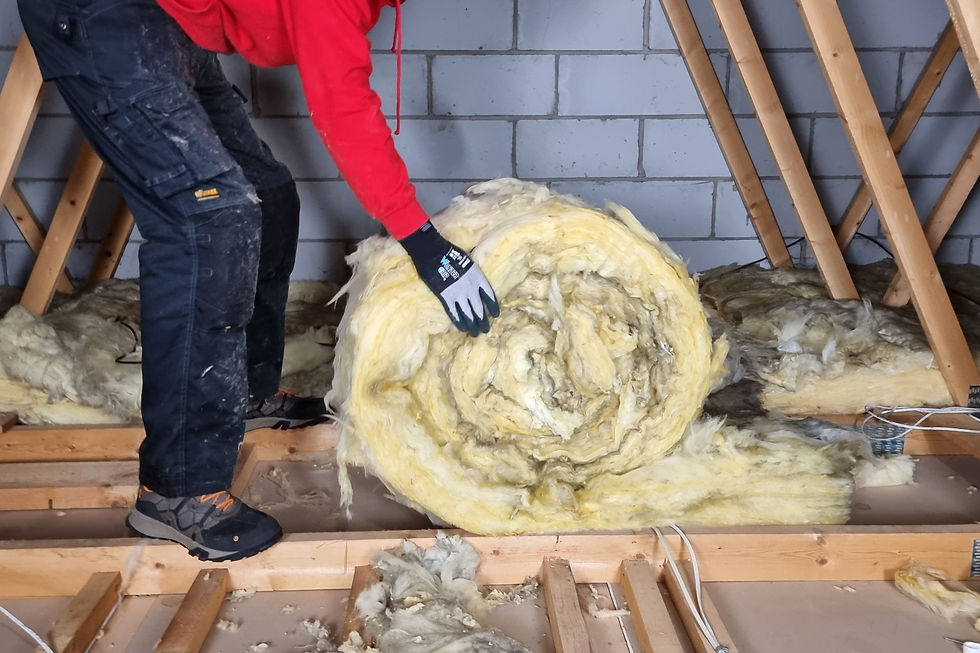The Top 5 Benefits of Loft Insulation - When It's Done Right
- Matthew Driver
- Sep 1
- 3 min read

Loft insulation is one of the simplest, most cost-effective improvements you can make to a UK home — but only if it’s installed correctly. Done well, loft insulation keeps heat where you want it, lowers bills and reduces your carbon footprint. Here’s how to get the full benefit.
How loft insulation works (quick overview)
Think of loft insulation as a warm woolly hat for your house. It forms a thermal barrier that slows the flow of heat from the living spaces up and out through the roof. The most common type for accessible lofts is mineral wool (quilt/batts), which is unrolled between and over joists to create a thick insulating layer.
Important installation note: don’t compress insulation. Squashing quilted insulation over joists cuts its thermal performance — sometimes by more than half. If you want a usable storage deck, use a raised boarding system (e.g., Loft Legs) to leave the insulation at its full depth and performance.

1. Prevents heat loss (so your home stays warmer)
A significant proportion of a house’s heat can escape through an uninsulated loft. Proper loft insulation reduces heat loss by roughly a quarter compared with an uninsulated roof, helping keep rooms warmer in winter and more comfortable year-round. That retained heat means your heating needs to run less often — which is the root of the savings below.
2. Cuts your energy bills
Because loft insulation reduces heat loss, it reduces how much energy you use to heat your home. Typical savings for a household with new, correctly installed loft insulation can be in the region of tens to low hundreds of pounds per year — many guides list savings up to around £110 annually, depending on house size and heating system. With insulation lasting decades, it usually pays back quickly.
Tip: look out for government or energy-company grants that can reduce or even cover the installation costs in some cases or see our blog on the subject here.
3. Lowers your carbon footprint
Using less fuel means emitting less CO₂. Correctly installed loft insulation can reduce household carbon emissions substantially — sources suggest annual savings can range widely depending on house size and construction, but the effect is significant. For homeowners aiming to be greener, insulation is one of the fastest, most cost-effective measures available.
4. Reduces noise and improves comfort
Insulation isn’t just thermal — it also provides some acoustic separation. A well-insulated loft can reduce external noise coming into the upper floors, improving comfort for bedrooms and any living spaces beneath the roof.
5. Helps improve your home’s value and EPC rating

Correctly installed loft insulation raises your Energy Performance Certificate (EPC) rating, making your property more attractive to buyers and potentially improving resale value. An energy-efficient home is easier to market and more appealing in today’s low-carbon, cost-conscious market.
Getting the benefits — practical tips
Target the right depth: Current guidance in the UK recommends a minimum of 270mm of mineral wool/quilt loft insulation for optimal performance. Make sure you (or your installers) maintain that depth as a minimum.
Avoid compression: If you need storage, create a raised floor above the insulation instead of walking or storing directly on top of it. Products that raise the boarding above the insulation preserve thermal performance.
Ventilation & airtightness: Insulation works best alongside good loft ventilation and an airtight ceiling below. Make sure loft vents and eaves are not blocked, seal gaps around loft hatches and seal Loft Lids over downlight fittings to maintain the airtightness of the ceiling.
Choose the right material: Mineral wool is common and effective, but blown-in and other specialist materials may suit particular lofts. Check manufacturers’ U-value claims and installation instructions.
Look for grants: Check local energy-saving schemes and national grants — they can reduce upfront cost considerably.
Are you a DIYer or prefer a pro?
Loft insulation and raised boarding is a popular DIY job for homeowners, we have created a downloadable guide with all the necessary information.
However, if you’re unsure about ventilation, your roof structure or creating a raised storage deck, a professional installer will ensure the job is done correctly, safely and provide guarantees for a number of years.
Want more help?
If you’re planning an upgrade, check our FAQs, download our guide above, or contact us for advice on raised boarding solutions that preserve insulation performance while creating usable loft storage. Done right, loft insulation delivers comfort, savings and long-term value.



Comments